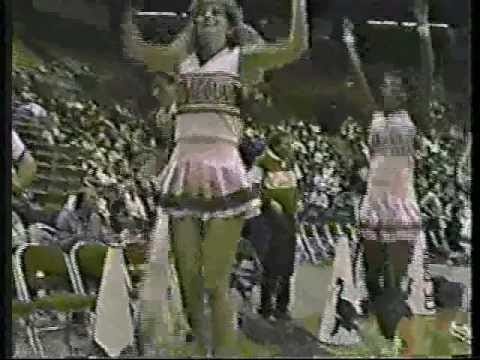Feeling Blue About The Demons: The Decline of DePaul Basketball Bums Me Out
WGN filled my childhood summers with Chicago Cubs baseball broadcasts and Harry Caray1. The Chicagoland network gave me some of my first tastes of the NHL, and was League Pass before League Pass with its regular airings of the Bulls.
The Superstation Channel 9 also aired DePaul basketball at some point in my childhood. While I have no vivid memories of watching the Blue Demons in the early ‘90s, a Blues Brothers inspired ad campaign for their telecasts planting a jingle firmly in frontal lobe for the rest of my life:
Doo-doo doo-doo doo-doot, De-De-DePaul!
Sadly, I couldn’t find that specific commercial, but YouTube did provide an ad from 1987. That was the sixth year in a 10-year span that DePaul finished ranked in the top 10 of the final AP Top 25.
Once the ‘90s arrived, DePaul was no longer the national powerhouse it had been in the 1970s and 1980s. But the Blue Demons were still good enough to continue making the NCAA Tournament and linger around the Top 25 for a few years.
What’s more, the program’s peak under legendary coach Ray Meyer was still fresh in the basketball world’s collective consciousness.
That’s all to say there’s a point in my basketball recollection that I understood DePaul basketball to be great. And as the Blue Demons began to slide in the mid-1990s and into the 21st Century, I believed them to be the proverbial Temporarily Embarrassed Millionaires.
The longer DePaul languishes not as an also-ran, but as a perennial cellar-dweller, the more evident that temporary is in fact permanent.
DePaul losing its 2023-24 season opener to Purdue Fort Wayne, 82-74, isn’t worthy a newsletter entry on its own. Fewer than 1,000 fans reportedly attending, on the other hand, genuinely shook me.
Chicago is and has long been one of America’s great basketball cities. Certainly I can attribute much of my association with the Windy City and hoops to the era in which I grew up, with Michael Jordan as the face of the game during its most meteoric rise.
Likewise, seeing Hoop Dreams as a sixth-grader ingrained in me the cultural importance of the game in Chicagoland schools.
For that reason, I long felt Chicago was deserving of great college basketball. And for years earlier, it had it.
From 1976 through 1992, DePaul only missed the NCAA Tournament three times; in contrast, the Blue Demons earned No. 1 seeds in the Big Dance more times over that same stretch with four.
The most famous of those top-seeded DePaul teams entered the 1980 Tournament 26-1. Mark Aguirre was the best player in the country, averaging almost 27 points per game, and a freshman Terry Cummings was putting up nearly a double-double a contest.
But DePaul played its worst game of the season in the 2nd Round of the NCAA Tournament, which was the Blue Demons’ opening-round contest in the old, 48-team format.
A 10-seeded UCLA team bounced the DePaul squad with the best hope a history-rich program ever had to win a national championship. Not only was that arguably the most talented bunch in the country that year, but the field was as wide-open as it had been in decades — made evident in a Final Four without a single No. 1 seed.
I don’t remember the specific question or context that I brought up the 1980 Tournament during a media session at the 2022 Final Four — yes, I somehow remember a WGN DePaul jingle and “Cub Fan, Bud Man” from the early ‘90s, but not a question I asked at an event less than two years ago.
Regardless what prompted my question, another reporter came up to me after the session to tell me about being a DePaul alum and the devastation he still felt four decades later from that loss.
The irony, he noted, was that in the previous decade DePaul couldn’t break the glass ceilings set by generational players like Magic Johnson, all-time legendary teams like the ‘76 Indiana Hoosiers — college basketball’s last unbeaten champion — and, of course, UCLA. So to lose to a decidedly down UCLA team, when DePaul had the best player in the game, stung that much worse.
It stings from a sympathetic perspective, too. Growing up watching the Cubs, I became conditioned to believing we’ll get ‘em next year, while deep down knowing next year may never come. That really felt like the case when, as a college student, I watched Game 6 of the 2003 NLCS in stunned disbelief.
Next Year did indeed arrive in 2016. But Major League Baseball features 30 teams and concludes with a postseason in which typically the best team will win out. Div. I college basketball currently has more than 350 programs and a postseason conducive to upsets.
And in college basketball, powerhouses can wither away faster and with less clear explanation than any other major sport.
I assume I was the only 7-year-old in Arizona who could sing “I’m a Cub fan and a Bud man” from memory.



